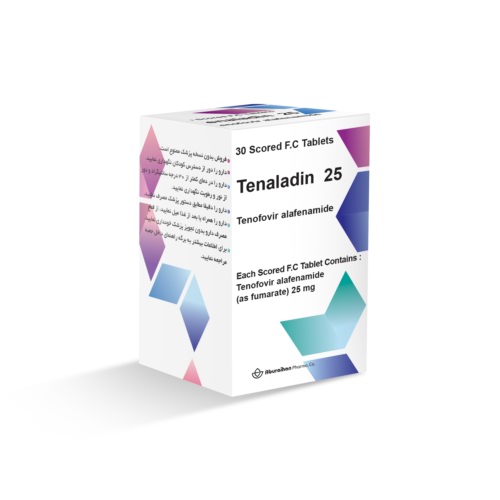Tenaladin
Tenofovir
Tablet
25 mg
- Chronic hepatitis B: Treatment of chronic hepatitis B virus infection in adults and pediatric patients ≥12 years of age with compensated liver disease.
- Although tenofovir alafenamide as a single agent is not FDA-approved for HIV-1 infection, it is approved for treatment and/or preexposure prophylaxis of HIV-1 infection as part of several fixed-dose combination products; refer to those product monographs for more information.
Mechanism of Action:
Tenofovir alafenamide, an analog of adenosine 5′-monophosphate, is converted intracellularly by hydrolysis to tenofovir and subsequently phosphorylated to the active tenofovir diphosphate. The active moiety inhibits replication of HBV by inhibiting HBV polymerase.
Method of Administration:
Chronic hepatitis B: Oral: 25 mg once daily
Notes
Tenofovir alafenamide is designed to deliver the active ingredient to the liver more efficiently, resulting in lower blood levels and a reduced risk of liver side effects and less need for monitoring.
Contraindications:
Hypersensitivity to tenofovir alafenamide or any component of the formulation.
Interactions:
Acyclovir-Valacyclovir: May increase the serum concentration of Tenofovir Products. Tenofovir Products may increase the serum concentration of Acyclovir-Valacyclovir. Risk C: Monitor therapy
Aminoglycosides: May increase the serum concentration of Tenofovir Products. Tenofovir Products may increase the serum concentration of Aminoglycosides. Risk C: Monitor therapy
Atazanavir: Tenofovir Disoproxil Fumarate may decrease the serum concentration of Atazanavir. Atazanavir may increase the serum concentration of Tenofovir Disoproxil Fumarate. Management: Use boosted atazanavir in adults; give combo (atazanavir/ritonavir or atazanavir/cobicistat with tenofovir) as a single daily dose with food. Pediatric patients, pregnant patients, and use of H2-blockers require dose changes. Risk D: Consider therapy modification
Ledipasvir: May increase the serum concentration of Tenofovir Disoproxil Fumarate. Management: Avoid this combination if TDF is used as part of the elvitegravir/cobicistat/emtricitabine/TDF product. Consider alternatives when TDF is used with a ritonavir or cobicistat boosted protease inhibitor. Monitor for increased TDF toxicities if combined. Risk D: Consider therapy modification
Nonsteroidal Anti-Inflammatory Agents: May enhance the nephrotoxic effect of Tenofovir Products. Management: Seek alternatives to these combinations whenever possible. Avoid use of tenofovir with multiple NSAIDs or any NSAID given at a high dose due to a potential risk of acute renal failure. Diclofenac appears to confer the most risk. Risk D: Consider therapy modification
Pregnancy and Lactation:
Tenofovir alafenamide has a low level of transfer across the human placenta. No increased risk of overall teratogenic effects has been observed based on limited data collected by the antiretroviral pregnancy.
It is not known if tenofovir alafenamide is present in breast milk. Breastfeeding is not contraindicated in patients with hepatitis B; however, if nipples are cracked or bleeding, breastfeeding is not recommended.
Tenofovir alafenamide is a recommended component of an initial regimen when acute HIV infection is detected in patients who are breastfeeding. Breastfeeding should be interrupted and not continued if infection is confirmed. Breast milk may be expressed and stored while waiting for confirmation.
Warning and Precaution:
- Lactic acidosis/hepatomegaly: Lactic acidosis and severe hepatomegaly with steatosis, sometimes fatal, have been reported with the use of nucleoside analogs, alone or in combination with other antiretrovirals. Suspend treatment in any patient who develops clinical or laboratory findings suggestive of lactic acidosis or pronounced hepatotoxicity (marked transaminase elevation may/may not accompany hepatomegaly and steatosis).
- Renal toxicity: Renal toxicity (acute renal failure, Fanconi syndrome, and/or proximal renal tubulopathy) has been reported with use of tenofovir alafenamide–containing products; patients with impaired renal function and those with concurrent or recent nephrotoxic therapy (including nonsteroidal anti-inflammatory drug use) are at an increased risk. Discontinue use in patients who develop clinically significant decreases in renal function or evidence of Fanconi syndrome
Adverse Reactions:
>10%:
Nervous system: Headache (12%)
Neuromuscular & skeletal: Decreased bone mineral density (≥5% at lumbar spine: 11%; ≥7% at femoral neck: 5%)
Storage:
Store below 30ºC and protect from light and moisture.

